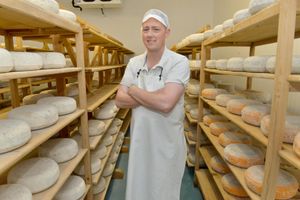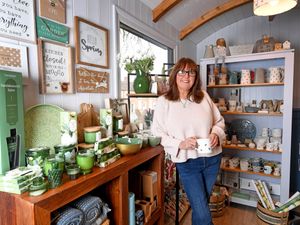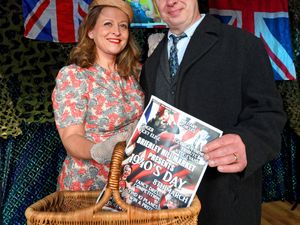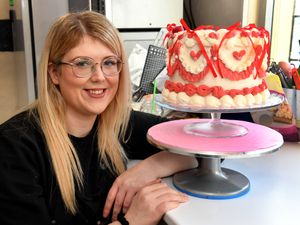What it's like to make cheese: Our cheese is gouda to go!
Martin Moyden lives and breathes cheese.

Inspired by his grandmother's tales of farming and traditional ways of food production, he set up his own artisan business 12 years ago.
Now with the help of his wife Beth and mother Ann, the 39-year-old makes hundreds of cheeses each week.
"I love taking that raw ingredient, the fresh milk from well-kept cows, and being able to make so many different styles of cheese
"It's one of the oldest ways of preserving milk and can be traced back over 9,000 years. You can take it in so many different directions to create cheeses with different flavours and a sense of place," says Martin.
It all at starts early in the morning at Moyden's Hand Made Cheese with the milking of the cows at around 5.30am.
Martin gets his milk from a neighbouring farm to his creamery, which is based at Lockley Villa Farm, near Wistanswick, Market Drayton.
There are Montbeliarde cattle, a red and white breed that produces a high quality milk that Martin says has a good balance of protein and fat.
"With buying milk people tend to want to skimmed nowadays and there is less protein and fat but with a cheese we are looking for a creamy milk with the right balance of protein and fat that comes through in the cheese," he explains.
The raw milk is then heated with the temperature varying depending on the type of cheese. For example, milk for the Caer Caradoc, which is based on a Caerphilly style of cheese, is warmed through until it reaches 30C (86F), while the Wrekin Blue will be slighter higher at 34C (93F).
Next a starter culture is added to help produce lactic acid followed by a vegetarian alternative to rennet to enable the milk to set like a blancmange.
This takes around half an hour and then it's cut to allow the separation of the curds and the whey.
It's continually stirred by hand so that the curds do not settle in one place.
"It's very hands-on work, by stirring the curds by hand we can tell when they are ready.
"We don't rely on any machinery, everything is done by hand using traditional methods because I think it's important for displaying the cheeses' provenance.
"All of our cheeses are named after well known Shropshire towns and landmarks," explains Martin.
Next they drain the whey and scoop the curds into moulds where they will be left in room temperature overnight before being salted.
"The whey is collected in a tank and sprayed on the fields as a fertiliser but ideally we would like to find a way to use it. In Italy, whey from the making of Parmesan cheese is fed to pigs and that is where Parma ham comes from.
"There shouldn't be any waste when making cheese so we are looking into options for using the whey in food production," says Martin.
There are four vats on the premises for making cheese which hold a total of around 2,150 litres (3,801 pints) of milk and it takes approximately 10 litres (17 and a half pints) to make each wheel of cheese.
They are stored in the maturing rooms designed to emulate the conditions inside a cave so they are both cool - around 12C (55F) - and moist.
The wheels of cheese are turned every day and are left to age for three to six months. "It's like wine-making, it's all about time. When they reach the correct maturity they are packed and are then ready for sale," says Martin.
They keep 'cheese logs' recording how the process has gone including the weather which can affect cheese-making as warmer temperatures will speed up the separation of the whey and curds.
Cheese-making takes place once or twice a week, depending on the demand from customers and they are stocked by farm shops and delicatessens across Shropshire and further afield.
"Our busiest time is Christmas because we sell twice as much cheese than we do at any other time of the year. January, February and March are quieter months for us so it gives us time to restock after a busy December.
"This time of year is busy too because people are eating outside and entertaining more so it can be nice to have a cheeseboard," says Martin.
The first cheese he produced was his Wrekin White, which has a nutty flavour and a fruity aroma, and he went on to produce the Wrekin Blue, the mellow Newport, the oak-smoked Newport 1665 and the crumbly Caer Caradoc.
He also introduced Ironbridge, a blue mould-ripened, 200g individual cheese truckle and makes a Cheshire-style hard cheese especially for Apley Farm Shop near Shifnal.
Making cheese has become a way of life for Martin and it all started because of the stories his grandparents, Bob and Margaret Mansell, used to tell him.
"My grandparents had a milk round in Newport. They would travel around in a horse and cart. My grandmother was always telling me about meeting the customers and talking to them about the cows and where the milk had come from.
"Nowadays we've become disconnected with where our food comes from. I wanted to reconnect people with where their food comes from and help them appreciate traditional methods of food production.
"Cheese seemed the best way to do this and at the same time reflect Shropshire provenance," he explains.




